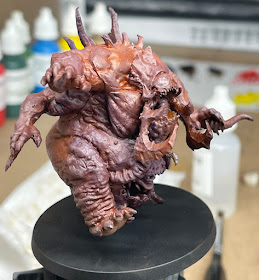Well, the entire Kabuki Gang was painted in just two sessions so I'm posting one update for them as they share the same pallet and are all similar. The first session laid out the bulk of the colors and regular details. The second, a few days later, added some pin-line washes, gold details, and various fabric designs. I figured it would be a lot easier to add the freehand designs after the underlying colors were closer to cured. I started by trying to paint the designs using oils, but the various yellows were a bit too transparent and I gave up on them after the first details of Iemon.
Unfortunately, I rushed the designs a bit so the details didn't turn out as good as they could have, but the acrylics did a decent job even though they were part of the reason I was rushing it. The paint drying on the brush was an unpleasant reminder of my painting past. The other part of rushing is definitely on me though as in hindsight I should have added some mediums to extend the drying time a bit...
The Kabuki Gang members have various B.I.A skills that can be pretty powerful, assuming they are being run by one player or by a group that tends to stick together. The Kabuki Gang members also have the special ability to draw from the equipment deck an extra starting item. That could help speed up the game a little bit, but with my luck, I'll draw an SMG every time. ;)
Problems with Oils
There were more issues, especially with the red areas (same Fanchon Red as the Babyface). These were painted immediately after the Babyface so I didn't know there were any issues until a week later when I tried adding the acrylic details. I have been unable to narrow down exactly what the problem is, but suspect the red along with the Winton Payne's Grey as well as possibly using Black Spinel as a pin wash. I'm moving forward with the following changes in hopes that it will eliminate future issues:
- Shake the paints better every time they are used
- Replaced Winton Payne's Grey with Gamblin's Payne's Grey
- Using a bit of Liquin with most/all colors
- Thinning the oils a bit more when on the palette
- Avoid Black Spinel as a pin wash
Paints used on these models:
Paints used for the detail phase:
Next up on the workbench:


















































